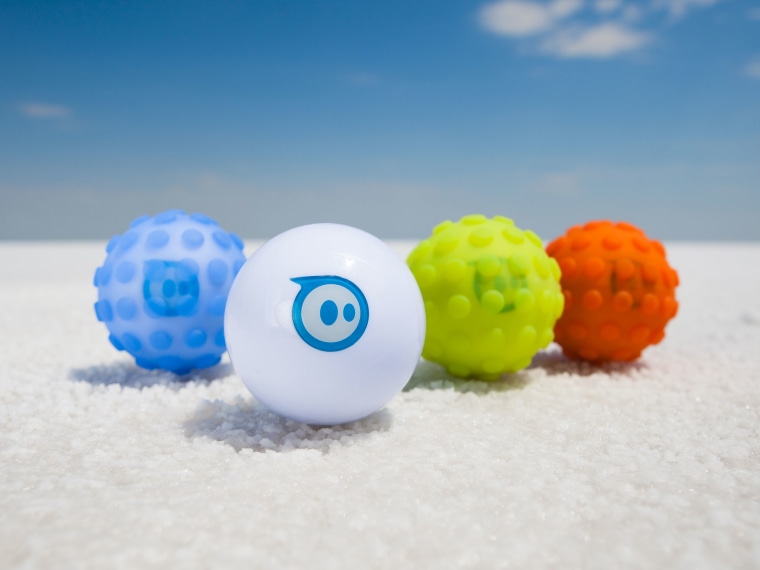When the tech startup Orbotix first introduced its smartphone-controlled robotic ball, the Sphero, back in 2011, the idea of controlling a toy with your iPhone was so novel that it struck many onlookers as a pure gimmick. And to many in the tech press, it was just that — Sphero was a cool idea and an adorable little gadget, but at $129.99 and with few interesting apps to show off all of its futuristic-sounding augmented reality apps, it was too expensive for kids and not practical enough for adults.
Two years a several fundraising rounds later, Orbotix has grown as a company. And with the release of "Sphero 2.0" at the end of this month (at the same price), Adam Wilson, Orbotix co-founder and chief software architect, hopes that his remote-controlled robotic ball has too.
"The new ball is way faster, way brighter," Wilson told NBC News recently as he played around with a Sphero 2.0. "There's a lot more intelligence in the device with the new firmware we've built into it this time."
Wilson admitted that the original Sphero "wasn't perfect yet" as a consumer electronics device. The new ball attempts to fix that with a few incremental tweaks — doubling its speed to about seven feet per second and tripling its brightness to help it stand out. But what's really unique about Sphero 2.0 is the ball's ability to "level up" as users play with it more.
"Leveling up" is a concept of self-improvement used in many video games that's since been popularized by many tech companies seeking to motivate their customers to do everything from lose weight to have more sex. A "World of Warcraft" player may spend hours killing bad guys in order to acquire the requisite experience to unlock a new suit of armor, say, while a Nike FuelBand or Fitbit Flex user will try to run more miles in order to "unlock" more badges. But with Sphero 2.0, Wilson claims that Orbotix is the first company to actually make a piece of hardware that levels up with its use.
"I want it to feel bad when kids have to give the Sphero away at the end of the night when their parents are telling them to pick up their toys," Wilson said. "The ball will grow with you as you use it more, you'll become personally attached to it as your Sphero."
With that in mind, Wilson also said that his company developed the new Sphero with children in mind, highlighting the ball's educational opportunities in particular.
Orbotix still takes a laissez-faire attitude towards the ball's software, emphasizing that they want it to be as open and hacker-friendly for as many different uses as possible. But at the same time, it's refreshing to a fuller host of first- and third-party titles than the ball originally offered.\
My personal favorite is "the rolling dead," an augmented reality game that lets you steer around the ball while shooting at zombies that appear on your smartphone or tablet screen. I'm not sure how "educational" fighting back the living dead is, exactly, but Wilson said that his main goal is to introduce the ball's DIY ethos into classrooms to ultimately help kids learn how to program their own Sphero apps. He noted that Orbotix has already started to introduce such programs to extracurricular classes to local schools near its headquarters in Boulder, Colo.
As part of this push to extend Sphero's reach beyond the tech-savvy crowd that would normally enjoy tinkering with robots in their spare time, Orbotix is also releasing an Apple-exclusive version of the new ball known as "Sphero Revealed," which has a partially clear shell so users can see the inner-workings of the robot without having to take it apart in the process.
With all that behind the robotics startup, what's next for Orbotix?
"We're not really sure yet," was all Wilson would say, admitting that while they would continue to support the Sphero following its launch, the company felt it had finally completed what it set out to do when it first to make the robotic ball. But he was quick to add that Orbotix had no intention to sell itself or the Sphero to any bigger toy or tech company.
"We want to try to build the next big thing on our own," he said, still toying with the tiny robot that first got his company started.
Yannick LeJacq is a contributing writer for NBC News who has also covered technology and games for Kill Screen, The Wall Street Journal and The Atlantic. You can follow him on Twitter at @YannickLeJacq and reach him by email at: Yannick.LeJacq@nbcuni.com.
